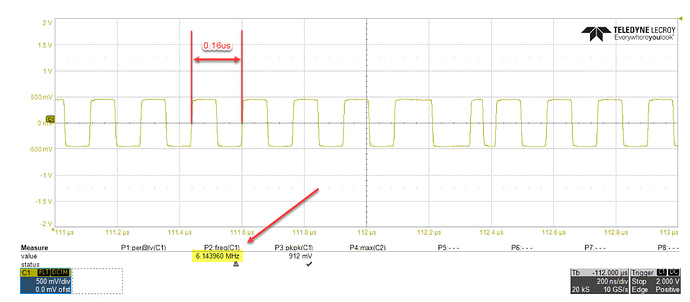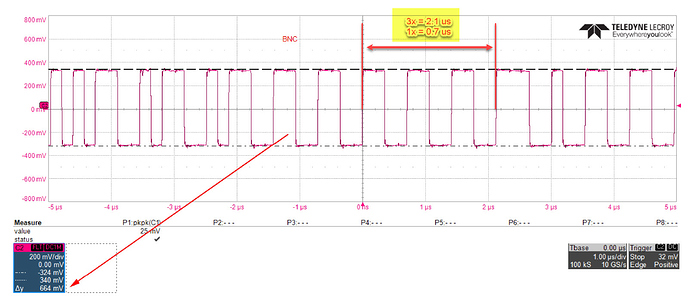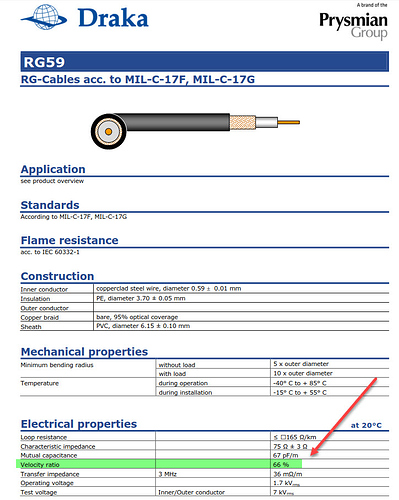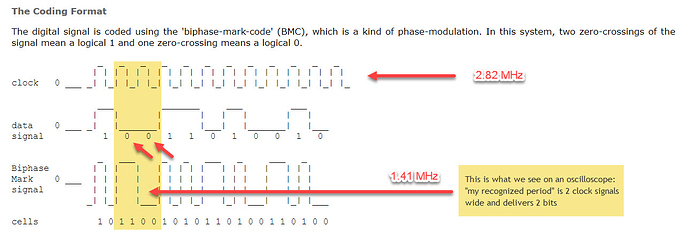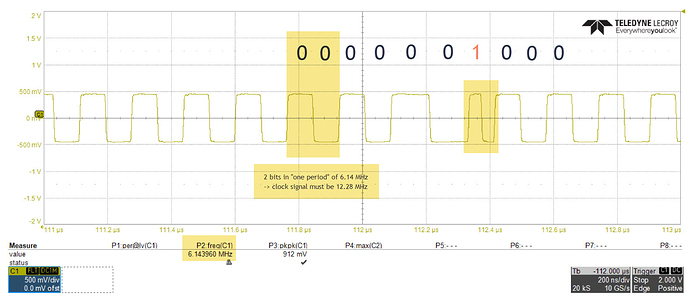I thinks it’s cool what your doing and will eagerly follow your journey, but just purely antidotal, I had a 1.3m Oyaide DB-510 BNC but just replaced it with a Triode Wire Labs 0.75m with BNC, and the TWL is much better in my system. I’m not sure if that article (I think that’s the Berkeley thought as well) is a universal truth.
Hi Tom
Alll data is taken at the output of the DigiOne. No data signal generator was used.
I have asked the team to look into your post and reply. No new testing is scheduled for DigiOne .
Hi Tom
quick question, are you affiliated in any way with empiricalaudio ?
@allo.com
Hi johan, thanks for checking that. Maybe your team can tell us how long the rise-time on a BNC-cable is (in nanoseconds). Again: Allo did a fantastic job with the DigiOne for a fair price!
Regarding your “quick question”: not at all. I had to google what “empiricalaudio” is 
@Bill_Soukoreff
Hi Bill, I think the article is the truth, physics hasn’t changed since 2004  . I am an electrical engineer and during my studies cable reflections were a big topic. But … if you have a good cable with good connectors (for sure you have one) and the DAC has a perfect input impedance of 75 ohm, no reflections will happen and a short cable is fine. But … I want to be “on the save side” … I prefer longer cables, at least the Triode Wire Labs with 1.23m
. I am an electrical engineer and during my studies cable reflections were a big topic. But … if you have a good cable with good connectors (for sure you have one) and the DAC has a perfect input impedance of 75 ohm, no reflections will happen and a short cable is fine. But … I want to be “on the save side” … I prefer longer cables, at least the Triode Wire Labs with 1.23m  . Anyway, I’m still wondering why such premium cable manufacturer like Oyaide or Triode Wire Lab don’t have longer BNC cables in their portfolio(?)
. Anyway, I’m still wondering why such premium cable manufacturer like Oyaide or Triode Wire Lab don’t have longer BNC cables in their portfolio(?)
Your right! And I can see why boutique manufactures don’t understand why the cable length important. But it is interesting that a company like Oyaide only offers two lengths 0.7m and 1.3m. Then you have a company like Black Cat who years ago when they introduced their first cable claimed that in their testing 1.23m was the perfect length. All of this is over my head and I glad there are people like you who share their knowledge and experience.
The other things that marvels me is how completely opposite these deigns are. The Oyaide is I believe solid core high purity silver, stiff like crazy, and the TWL is think is all copper, but I could be wrong on that, but it is so supple, you can wrap it around your wrist. That really surprised me.
@Bill_Soukoreff
Bill, did you really recognize a difference between the Oyaide DB-510 1.3m and the Triode Wire Labs 0.75m, because both seems to be outstanding cables? You are right, Triode Wire Labs uses copper, Oyaide silver. Back to the difference:
- difference in sound quality or
- only in stiffness (wrap around your wrist sounds good)
Regards
Tom
@allo.com
@Bill_Soukoreff
One more thought on that … maybe we (especially you Bill with your top notch cable) are anyway on “the save side” in case of Allo can agree that the output impedance of the BNC connector of the DigiOne is “perfect 75 ohm” ?
In this case, the reflection of the DAC is anyway “dead” when it runs back into the BNC connector of the DigiOne  Allo … please … agree that this is the case !!!
Allo … please … agree that this is the case !!!
Hi Tom
your first link is written by empiricalaudio , not sure why you had to google again. Your questions for rise time etc…in somewhere in the middle of article .(written by Steve N). Even the speed or propagation in cable that you mention is in Steve N article…
You “study” cable reflections in BNC . Funny , EA has a BNC cable business (silver cable for 499$ +84$ shipping) with some type of measuring how they are the greatest vs other cables.
Did I forget to mention that EmpiricalAudio is selling some type of Spidif recloaker ( Synchro-Mesh) for 600$ (but based on ASRC) ?
Hi johan,
now I understand your thoughts, I just saw the last line of my first link, for me it was something of “positive-feedback.com” … 
Really johan, believe me, I have absolutely nothing to do with empiricalaudio. I live in Switzerland, far away from the “Black Butte Ranch CPU, USA” (found adress on their webside).
Regarding my studies (University of Stuttgart, Germany), I studied “telecommunication engineering” and again belive me, cable reflections are a big topic in telecommunications … ask your engineers. That’s why I agree to the physic stuff described in this link. Independent if there is some “commercial stuff inside”  or not, the described physic is true.
or not, the described physic is true.
The reason I got the Oyaide some years ago is due to reports that is was a very analog (sorry I hate to use that word) sounding digital cable. The TWL is similar but delivers a more refined and elegant presentation yet with even a little more detail. The only reason I replaced it, it was starting to cut out at times.
Steve N is somewhat polarizing in the industry, and I think he likes to play that role. I believe on Audio Circle he posted that he is going to make a DIY hat for the Raspberry “as no one does it right”, so I think that’s why Johan from Allo might be suspicious.
I have never heard anything from Empirical Audio. But I can say I have had some pretty decent gear though my system and the Digione BNC into my DAC is the best sound I have ever had. Amazing price per performance ratio.
Is there a SQ improvement by powering the DigiOne board from a seperate high quality power supply from the Raspberry supply? Thank you.
You need to try it and see whether you hear any difference. It makes no difference if someone else hears a difference, only what you hear is relevent.
Do you have a possibility to do that without soldering?
I have a version 1.1 which has no seperate connection for power.
Hi
mmm there are a few pseudo facts in your post.
First where in our data you see 1.4Mhz data signal ? Nowhere.
Second you say that BNC signal is 340mV out of SPIDIF specs…incorrect again. BNC spidif should be 0.5-0.6v pk/pk and we are at 0.66ok/pk at the cable end (yes we took that in consideration) .
We are checking rise time but we need to make the setup. Our test engineer remember is being very good at about 1.2ns
And yes I confirm that we have a real 75Ohm connector on BNC and yes we took care of the R and impedance on the PCB
You need to remove the DC/DC convertor , basically you need soldering skills
Rudy you have to make changes to the DigiOne board,
@allo.com
Hi johan,
here are some comments to my “pseudo facts”:
1) "First where in our data you see 1.4Mhz data signal ? Nowhere"
When I have a look at “DIGIONE-SPDIF-OUT-BNC.pdf”, I can see a 0.16us = 160ns (nanosecond) period, now let’s calculate frequency: 1 / 0.000’000’16s = 6’250’000 Hz = 6.25 MHz (the document shows 6.14 MHz which is for sure more precise) !
Now we do the same with your document “BNC-OUT-Cable-Side.pdf”, I can see a 0.7us = 700 ns (nanosecond) period, now let’s calculate frequency: 1 / 0.000’000’7s = 1’430’000 Hz = 1.43 MHz !
2) "Second you say that BNC signal is 340mV out of SPIDIF specs…incorrect again."
There is one important thing, there is a question mark behind: “out of SPDIF specification?”, which means “I’m not sure”, in my mind was -0.5V - 0.5V (that’s exact what German Wikipedia page says). epanorama says receiver Vin: 0.2Vpp … 0.6Vpp
-> fine … signal is in spec 
3) "Even the speed or propagation in cable that you mention is in Steve N article…"
Steve said: “2 nanoseconds per foot” -> 0.305 m / 2 = 0.15m / nanosecond.
My 0.2m / nanosecond is more precise for me, I will explain why: everybody knows speed of light in vacuum = 300’000 km/s = 0.3m/ns (in physic known as constant “c”, remember Einsteins E = mc^2). If you check cable specifications, there is sometimes a factor called “velocity ratio” available, which is the factor to calculate speed in a cable. I have a standard BNC cable, a “Draka MIL-C-17F”, which as velocity ratio of 0.66:
0.3 m/ns * 0.66 = 0.2 m/ns (WOW, I got this without help of Steve, yipieee)
4) "And yes I confirm that we have a real 75Ohm connector on BNC"
Perfect, this is really good to know -> reflections are not an issue with DigiOne !
Johan, we are on the “same side”. I’m a happy customer of Allo, I enjoy my DigiOne every day (btw: I have 2 Boss DACs too). I never wrote something bad about this fantastic product, not in this thread, not in other threads somewhere else. I never had a “ground issue”, I can touch my system where ever I want: Amp, DAC, Pi, cables … DigiOne plays and plays … maybe because of the good Swiss electricity from hydroelectric power stations. Ahhh … I think I got my next topic: what sounds better, DigiOne powered from hydroelectric power station or from a nuclear power station 
Johan, let’s cool down and let’s enjoy the DigiOne with good music …
Best regards
Tom
Hi Tom,
Please accept my apologies, it seems that I jumped at conclusions . Again, sorry.
On your graph (bnc out cable side) you are making one error. The 3 pulses do not represent 1 , they are in fact at least two pulses wide (as you can see from a pulse thats to the right in your graph)
In that case …the frequency doubles to 2.86Mhz .
Regarding BNC signal…anything under (or equal to) 0.2 is consider low (even if you go to -0.5) and its consider high at+ 0.5 (but you can go to +1v) and you will still be in specs. In fact , on our internal testing we have found that some DACs repond better at 0 to 0.75V (older unit)
Team will do some testing to have the rise time etc and we will use 96Khz as you suggested (next week we will publish the data). Have fun and yes lets enjoy the good music. 
@allo.com
Hi johan,
apology accepted, no problem at all !
… and now we got it: yes, we have 2.86 MHz (or more precise the official 2.82 MHz) !
I checked the codec of SPDIF, and SPDIF uses a ‘biphase-mark-code’ (BMC), which is a kind of phase-modulation (epanorama.net). That means, what I assumed as a period is as you said the modulation of 2 bits:
But there is one more: I think we have the same situation with the document “DIGIONE-SPDIF-OUT-BNC.pdf”. The oscilloscope automatically recognized (like I did) the wrong period, because “it’s the most shown period”. But there is one “1” in the datastream with a lot of “0”, so the frequency must be 12.28 Mhz, which means data is from a 192 kHz source -> PERFECT !
Maybe your team can remember the source which was taken (ok, it was last May, maybe difficult), but can be interesting for the tests of next week …
I am listening now to The Latin Jazz Trio. DigiOne Player, connected to my Resolution Audio Opus XS DAC using RCA-RCA SPDif.
All I can say is wow, and thank you @allo.com!
This is perfect device, especially for setup like mine. High quality DAC (4 BurrBrown PCM1704 24-bit converters, 16x digital filter upsamples to 705 kHz/24-bit), but old now, and with outdated synchronous USB Audio 1 input. DigiOne Player does simple task: receives data stream over Ethernet, and coverts it to bit-perfect SPDIF signal. It does the task perfectly. I cannot imagine better device to perform this task. So instead of buying new DAC, for only 200 USD I have networked Roon Output device, small, silent, delivering perfect SPDIF signal to my beloved DAC. So now I can sit, relax and listen to Hi-Res music on my system.
PS.
I did only one modification to the DigiOne Player, I changed the power supply to Ultra Linear Power Supply from Tomanek (Polish company).
So again, thanks @allo.com, great product. Now I am going to buy USBridge to feed my headphone system.
